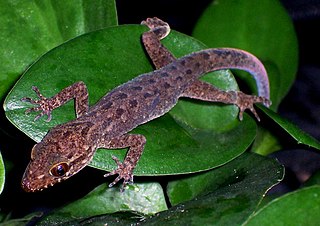
Cyrtodactylus is a diverse genus of Asian geckos, commonly known as bent-toed geckos, bow-fingered geckos, and forest geckos. The genus has 354 described species as of 2023, which makes it the largest of all gecko genera.

Pseudocalotes is a genus of lizards in the family Agamidae. The genus is endemic to Southeast Asia.

Antidesma is a genus of tropical plant in the family Phyllanthaceae formally described by Linnaeus in 1753. It is native to tropical Africa, S + E + SE Asia, Australia, and various oceanic islands. The greatest diversity occurs in Southeast Asia.

Mallotus is a genus of the spurge family Euphorbiaceae first described as a genus in 1790. Two species are found in tropical Africa and Madagascar. All the other species are found in East Asia, the Indian Subcontinent, Southeast Asia, eastern Australia, and certain islands of the western Pacific. The genus has about 150 species of dioecious trees or shrubs.
Trigonostemon is a plant genus of the family Euphorbiaceae and the sole member of its tribe (Trigonostemoneae). It was first described as a genus in 1826. It is native to Southeast Asia, southern China, the Indian Subcontinent, Queensland, and a few islands in the western Pacific.
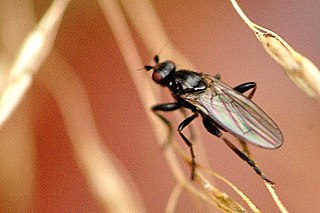
Sphaeroceridae are a family of true flies in the order Diptera, often called small dung flies, lesser dung flies or lesser corpse flies due to their saprophagous habits. They belong to the typical fly suborder Brachycera as can be seen by their short antennae, and more precisely they are members of the section Schizophora. There are over 1,300 species and about 125 genera accepted as valid today, but new taxa are still being described.

The Micropezidae are a moderate-sized family of acalyptrate muscoid flies in the insect order Diptera, comprising about 500 species in about 50 genera and five subfamilies worldwide,. They are most diverse in tropical and subtropical habitats, especially in the Neotropical Region.

Thiania is a genus of jumping spiders that was first described by Carl Ludwig Koch in 1846.

Clusiidae or "druid flies" is a family of small, thin, yellow to black acalyptrate flies with a characteristic antenna and with the wing usually partially infuscated. They have a cylindrical body. The head is round, the vertical plate reaches the anterior margin of the frons and the vibrissae on the head are large. The costa is interrupted near subcosta and the latter developed throughout length. Larvae are found in the bark of trees, the flies on trunks. The larvae are notable for their ability to jump. Males of many species in the subfamily Clusiodinae have been observed while engaged in lekking behaviour. There are hundreds of species in 14 genera found in all the Ecoregions, although most species occur in tropical regions. The type genus is Clusia Haliday, 1838.

The Neriidae are a family of true flies (Diptera) closely related to the Micropezidae. Some species are known as cactus flies, while others have been called banana stalk flies and the family was earlier treated as subfamily of the Micropezidae which are often called stilt-legged flies. Neriids differ from micropezids in having no significant reduction of the fore legs. Neriids breed in rotting vegetation, such as decaying tree bark or rotting fruit. About 100 species are placed in 19 genera. Neriidae are found mainly in tropical regions, but two North American genera occur, each with one species, and one species of Telostylinus occurs in temperate regions of eastern Australia.

The Pyrgotidae are an unusual family of flies (Diptera), one of only two families of Cyclorrhapha that lack ocelli. Most species are "picture-winged", as is typical among the Tephritoidea, but unlike other tephritoids, they are endoparasitoids; the females pursue scarab beetles in flight, laying an egg on the beetle's back under the elytra where the beetle cannot reach it. The egg hatches and the fly larva enters the body cavity of the beetle, feeding and eventually killing the host before pupating. In the United States, some species of Pyrgota and Sphecomyiella can be quite common in areas where their host beetles are abundant. Like their host beetles, these flies are primarily nocturnal, and are often attracted to artificial lights.
Stibadocera is a genus of crane fly in the family Cylindrotomidae. Stibadocera are unusual for crane flies in that the males have very long antenna, sometimes as long as the body. Most species are very small (6–10 mm).
Timia is a genus of flies in the family Ulidiidae, which is difficult to separate from the genus Ulidia.
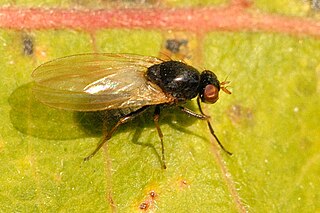
Calliopum is a genus of small flies of the family Lauxaniidae.

Loxocera is a genus of flies and member of the family Psilidae.

Limosininae is a subfamily of flies belonging to the family Sphaeroceridae, the lesser dung flies.
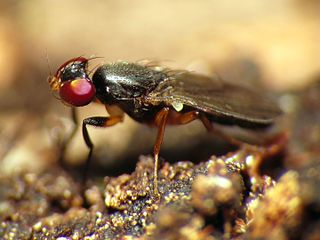
Heteromeringia is a genus of flies in the family Clusiidae. There are more than 70 described species in Heteromeringia.
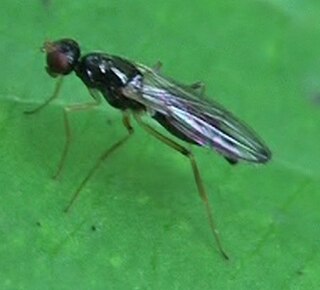
Strongylophthalmyia are a genus of slender, long-legged flies, the majority of which occur in the Oriental and Australasian regions.
Erymus gracilis is a species of rove beetle widely spread in Oriental region. It is found throughout China, Sri Lanka, India, Bhutan, Thailand, Malaysia, Laos, Indonesia, Myanmar, and Nepal.
Bowie is a genus of Ctenidae that was described by Peter Jäger in 2022. The genus was named after the English singer-songwriter and actor David Bowie and currently encompasses 107 species, 55 of which were named after elements from David Bowie's musical catalogue.















